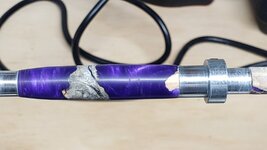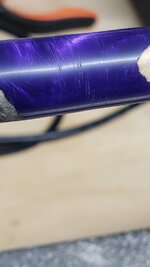YoYo
Member
Hi folks,
I just finished turning my burl pen blank and now in sanding process. I first used the sand paper from lowest grit to 600. Then, wet micro mesh from lowest to 12,000. I actually hesitate to use the wet MM because there is wood part. Anyway, there are scratches on it still. I have one step polish and I used it on the area, then used micro mesh sand it again, still didn't work. What should I do at this point? Also, how do I make this shinny that won't fade away?
Thank you
 .
.
I just finished turning my burl pen blank and now in sanding process. I first used the sand paper from lowest grit to 600. Then, wet micro mesh from lowest to 12,000. I actually hesitate to use the wet MM because there is wood part. Anyway, there are scratches on it still. I have one step polish and I used it on the area, then used micro mesh sand it again, still didn't work. What should I do at this point? Also, how do I make this shinny that won't fade away?
Thank you


